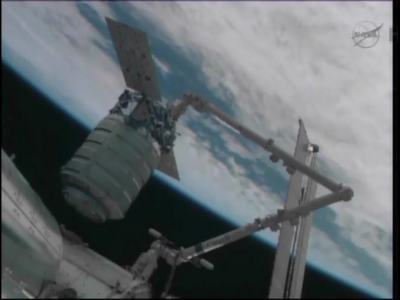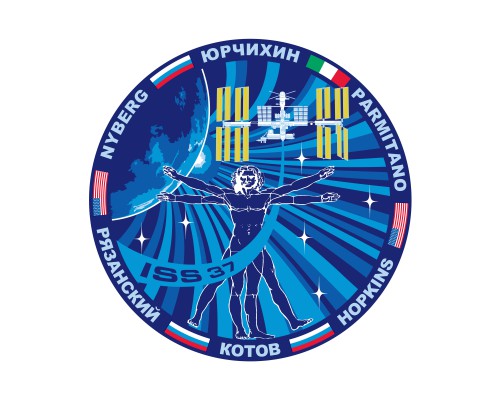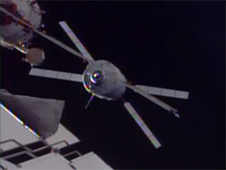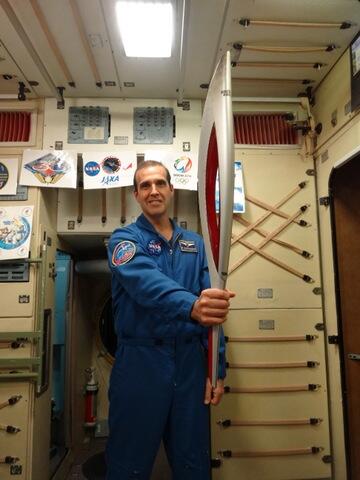
Despite the disruption caused by the ongoing U.S. Government shutdown, activities aboard the International Space Station (ISS) continue to press on, with several departures and arrivals of visiting vehicles in the next few weeks. On Tuesday, 22 October, Orbital Sciences Corp. will bid farewell to its first Cygnus cargo ship—currently flying its “Demonstration Mission” (designated “ORB-D”)—after three weeks berthed at the Earth-facing (or “nadir”) port of the Harmony node. Also next week, Europe’s Automated Transfer Vehicle (ATV)-4 “Albert Einstein” will perform a scheduled reboost of the station’s altitude, ahead of its own undocking from the aft port of Russia’s Zvezda module on 28 October.
The government shutdown has made for a quiet few days in terms of ISS news, with Orbital Sciences, the European Space Agency (ESA), and tweets and Earth photographs from Expedition 37 crewmembers Karen Nyberg, Luca Parmitano, and Mike Hopkins providing the only coverage of their activities in space. Next Tuesday’s departure of the ORB-D Cygnus will make the triumphant conclusion of Orbital’s Commercial Orbital Transportation Services (COTS) commitment, which clears the way for its first dedicated resupply flight, under the $1.9 billion Commercial Resupply Services (CRS) contract with NASA. Under the terms of the latter contract, Orbital will fly as many as nine CRS missions by 2016, with the first mission—designated “ORB-1″—presently scheduled for launch on 15 December from Pad 0A at the Mid-Atlantic Regional Spaceport (MARS) on Wallops Island, Va.

In a manner not dissimilar to its rendezvous and berthing at the ISS on 29 September, the departure of ORB-D will be conducted using the 57-foot (17-meter) Canadarm2 mechanical arm, which will physically separate Cygnus from the station’s Harmony node and release it into free flight. “The crew will detach it from Harmony, maneuver it out to the release point and then will ungrapple the vehicle,” noted Orbital in its ORB-D pre-flight press kit. “Cygnus will perform a series of engine burns that will place it on a trajectory to take it away from the vicinity of the ISS. Mission Control in Houston will then confirm that Cygnus is on a safe path away from the complex.” Next day, Wednesday, 23 October, the cargo ship will execute a seven-minute de-orbit burn to cause it to re-enter Earth’s atmosphere to destruction.
Last week, Orbital provided additional details about the exact details of the unberthing and departure events. “Orbital’s Cygnus team has updated its thruster burn schedule for the spacecraft’s controlled re-entry into the Earth’s atmosphere,” the company revealed on its Antares-Cygnus updates page. According to the company, Canadarm2 will unberth Cygnus from Harmony at approximately 6 a.m. EDT Tuesday and release the craft at about 7:30 a.m. Re-entry into the atmosphere is anticipated at around 2:18 p.m. EDT Wednesday, at a location over the Pacific Ocean, to the east of New Zealand. Unlike SpaceX’s Dragon cargo ship—which can survive atmospheric re-entry and perform a parachute-assisted ocean splashdown—Cygnus is intended to burn up at the end of each mission.
It has been a dramatic five weeks for the first flight of Cygnus, which is named in honor of the late G. David Low, a former shuttle astronaut and Orbital senior executive, under whose leadership the COTS and CRS relationship with NASA was conceived, matured, and reached fruition. Cygnus is a two-piece spacecraft, comprising a Pressurized Cargo Module, built by Thales Alenia Space and based in design upon the Multi-Purpose Logistics Modules (MPLM) used by the now-retired space shuttle, and Orbital’s home-built Service Module.

ORB-D got underway on 18 September, with the spectacular launch of Orbital’s second Antares rocket from Pad 0A at the MARS site, but the cargo ship’s planned four-day flight profile to reach the ISS on 22 September was repeatedly delayed. The first attempt to rendezvous with the station was called off, when “Orbital … established direct data contact with the International Space Station and found that some of the data received had values that it did not expect … causing Cygnus to reject the data.” This interrupted the rendezvous and a 48-hour delay was imposed, but the impending launch of the Soyuz TMA-10M crew—consisting of Russian cosmonauts Oleg Kotov and Sergei Ryazansky and U.S. astronaut Mike Hopkins—on 25 September forced another delay until after their arrival aboard the ISS.
Eventually, and with perfection, Cygnus completed a smooth approach and berthing on 29 September. Since ORB-D is a demonstration mission, none of the cargo ship’s 1,300 pounds (590 kg) of supplies were of a critical nature, although the criticality of its 10 Demonstration Objectives—conducted in the first few days of the flight and during the rendezvous with the space station—were essential for it to be deemed a success. After being berthed at the nadir Harmony port, the hatch into Cygnus’ Pressurized Cargo Module (PCM) was opened on 30 September and the astronauts, wearing goggles and face masks to guard against the danger of atmospheric particulate debris, ventured inside to begin removing payloads and supplies. Mike Hopkins described the smell of space. “Before ISS hatch to Cygnus was opened,” he tweeted, “small area between vehicles was at vacuum, which left a distinct odor.” Inside the cargo ship, touchingly, Orbital had attached a photograph of G. David Low.
By 7 October, it was announced that the Expedition 37 crew had completed the process of unloading cargo from Cygnus and had packed the first layer of waste for disposal, with a second layer in the next few days and a third and final layer planned for this week. Completion of the loading of trash will be followed by the close-out of the PCM, preparatory to unberthing. The conclusion of the ORB-D mission will clear the road for the launch of the dedicated ORB-1 mission on 15 December. According to NASASpaceflight.com, the second Cygnus will rendezvous and berth at the ISS on 18 December and will spend about three weeks in residence, with departure planned for 10 January 2014. Further missions (ORB-2 and ORB-3) are tentatively manifested for launch in May and October 2014.

Concurrent with the Cygnus closeout activities, although at the opposite end of the ISS, Europe’s ATV-4—named in honor of the great theoretical physicist Albert Einstein—is nearing the end of its own lengthy voyage. Launched on 5 June, aboard a giant Ariane 5 booster from the Guiana Space Centre in Kourou, French Guiana, the ESA cargo ship docked at the Zvezda module on 15 June with the largest amount of dry cargo ever carried aboard a European spacecraft and is wrapping up a 4.5-month mission. Current plans call for it to perform its final reboost of the ISS orbit on 24 October.
Last week, ESA announced that all of ATV-4’s dry cargo has been transferred to the station, together with all of its supply of water, air, oxygen, and propellant. The Expedition 37 crew was scheduled to perform a second session of ATV undocking training yesterday (Tuesday), and the final cargo and trash transfers are planned over the next few days. At length, on 25 October, hatches between ATV-4 and the station will be closed. Undocking from Zvezda will follow on 28 October, and the cargo ship will execute a destructive descent into the atmosphere on 2 November.
With the departure of ATV-4 from the aft port of Zvezda, Expedition 37 crewmembers Fyodor Yurchikhin, Karen Nyberg, and Luca Parmitano will board their Soyuz TMA-09M spacecraft—currently docked at the Earth-facing Rassvet module—on 1 November and perform a “relocation” maneuver. They will dock at the Zvezda aft port, clearing Rassvet for the arrival of Soyuz TMA-11M and its crew of Russian cosmonaut Mikhail Tyurin, NASA astronaut Rick Mastracchio, and Japan’s Koichi Wakata on 7 November. As described in a recent AmericaSpace article, the new arrivals will temporarily boost the station’s population to nine residents, for the first time since the end of the shuttle era.
One of the key reasons for this unusual “direct crew handover” is to carry a simulated Olympic torch for next year’s Sochi Games into orbit aboard Soyuz TMA-11M. Cosmonauts Kotov and Ryazansky will take the torch outside during a 9 November spacewalk, and which will be brought back to Earth by Yurchikhin, Nyberg, and Parmitano aboard Soyuz TMA-09M on 11 November. “We will take a picture of it with the space station in the background, with the Earth in the background,” said Kotov during his pre-flight interview, “and we will try to make sure that we see Russia and maybe Sochi. We want them to be in the background.” Tweeting yesterday to his 12,800 followers, Koichi Wakata detailed his final exam on the Russian Orbital Segment (ROS) systems and described how he had the chance to hold a model of the Olympic torch.
Want to keep up-to-date with all things space? Be sure to “Like” AmericaSpace on Facebook and follow us on Twitter: @AmericaSpace



